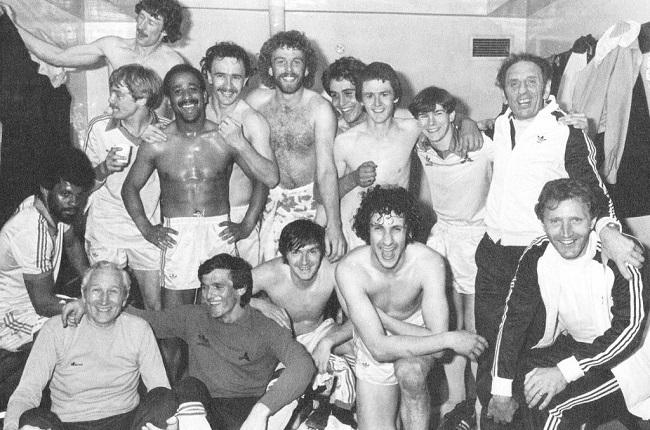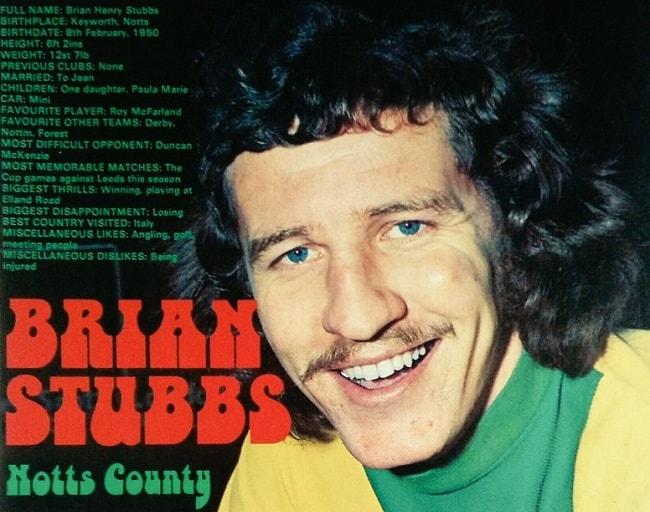Search the Community
Showing results for tags 'jimmy sirrel'.
-
On this day in 1981, Notts County experienced one of the finest days in their history when they claimed a 2-0 win over Chelsea at an intimidating Stamford Bridge to secure a return to the top flight after an exile of more than half a century. When the Magpies had last graced the top flight, penicillin had not yet been discovered, the BBC did not yet exist, and women under the age of 30 were not yet allowed to vote. The last Notts top-flight game was in 1926 and few could have expected such a drought from the elite level of English football. However, Jimmy Sirrel oversaw a revival at Meadow Lane which culminated in the iconic win in West London on 2 May 1981. The match itself proved a fiery affair and was held up for 15 minutes soon after Notts went two up as Chelsea fans invaded the pitch to demonstrate against their chairman, and there was another protest at the final whistle which resulted in the crossbar at the Shed end being broken. Nonetheless, the bottom line was that Notts sealed a top-three place in Division Two thanks to the result. Here is some media from the day - the television report on ITN (as far as I know this is as much as there is in terms of video highlights). Here are the final 10 or so minutes of radio commentary by Brian Tansley and Terry Bowles on Radio Trent (credit to KorkInNotts for the video). And here is a link to a short clip of Colin Slater commentating on Harkouk's goal. http://jkpkwa.bay.livefilestore.com/y1ptj1jMsTm2lRC0mhAH9IrgmPrYvKj1isP2bJAoR1-5WFUW_FPFANePNtkKUXeSiyxCsdMwCC8wLFhzP2WniAV2A/1981-05-02Promotion.mp3 Share your thoughts about the game on Pride of Nottingham by signing up to the website, visiting the forum and joining in the chat with hundreds of fellow Notts County fans. Fancy showcasing your brand or business on Pride of Nottingham? Click here to find out more about sponsorship and advertising opportunities with us.
- 1 comment
-
- notts county
- history
-
(and 2 more)
Tagged with:
-
The word "legend" is bandied around all too lightly nowadays. But if you ask any Notts County fan to name one individual and one individual only who deserves the tag of "legend", chances are they will name Jimmy Sirrel. Born on 2 February 1922 in Glasgow, James Sirrel's professional football journey began when he was 24, when he joined Celtic in 1946. He made just 13 appearances in three years before joining Bradford Park Avenue in 1949, where again he found game time limited, playing just 12 matches. In 1951 Sirrel joined Brighton & Hove Albion, where he made 55 appearances before signing for Aldershot in 1954, and he retired from playing in 1957. Modest a footballing career as it may have been, Sirrel's coaching career would be anything but, as he moved to Brentford as trainer in 1965 before becoming caretaker manager in February 1967. After being appointed to the role full-time, Sirrel spent two full seasons at the helm of Brentford, but soon enough, he would up sticks to Nottingham, where his career would go to dizzying new heights. On 19 November 1969, Sirrel entered the Meadow Lane gates for the first time as he would become the manager of Notts County, a team struggling in the Fourth Division. From previous managers Jack Wheeler - who would serve as his assistant - and Billy Gray, Sirrel had inherited a team including Don Masson, David Needham, Bob Worthington and Les Bradd, and he set about reinvigorating the players and the team. Sirrel's first season in charge of the Magpies ended with a respectable seventh-placed finish, but this was only a precursor to what was to come as, the following season, the team stormed to the Fourth Division Championship. Notts boasted a mean defence which would concede just 36 goals that season, while up top, the front line scored an average of 2.47 goals per game. By no means had Notts reached their limit - the following season, promotion to the Second Division was missed by just three points, and even though 1972-73 began slowly for the Magpies, sititng 16th by the end of the year, they would lose just twice more en route to second place and a spot in the Second Division. Already Sirrel had transformed Notts from fourth-division strugglers to a side punching their weight in the second tier, and when he decided to try his luck at top-tier Sheffield United in 1975, his place as a Magpies legend was already assured. Unfortunately for Sirrel, the Blades role would not go to plan as they were relegated that season and, with little money to spend, was unable to stop the side mounting a promotion challenge - but he still made his mark by designing the United badge that's currently being used today. Eventually, Sirrel opted to return to Notts - who were struggling to avoid relegation back into Division Three - in 1977, and breathed new life into the club by saving them from the drop. It took a while to get Notts back up to scratch, but the crowning moment came in 1980-81 when a 2-0 win over Chelsea at Stamford Bridge gave the Magpies top-flight football for the first time since 1926. Finishing 15th in his first season, Sirrel inspired his team to emphatic wins over Aston Villa, Arsenal, Nottingham Forest and Leeds United. In 1982, Sirrel became general manager, with Wilkinson taking over as boss, but he was back in the dugout in 1985 with Notts on the brink of back-to-back relegations under Larry Lloyd. Unfortunately, he was unable to prevent the drop, but did manage to halt the free-fall that County were in by consolidating in the Third Division for two more seasons, before retiring at the end of the 1986-87 season, eighteen years after he arrived at the club, his name in the club's annals assured. Sirrel was a regular spectator at Meadow Lane beyond his retirement and had the County Road Stand named after him, which he described as "a bloody honour" upon receiving the call from Derek Pavis. He was even called back into the dressing room and onto the pitch to boost spirits when Notts nearly slipped out of the Football League in 2005, such was his esteem at the club. On 25 September 2008, Sirrel sadly passed away aged 86, which led to an outpouring of grief from the Notts community and beyond. His funeral, on 7 October, was attended by fans and fellow peers from the world of football, who turned out to pay their respects. Jimmy Sirrel is the epitome of a Notts County legend, and his name continues to be chanted by the Black and White Army today, testament to just how revered he is at NG2. Share your thoughts about this Notts Alumni article on Pride of Nottingham by signing up to the website, visiting the forum and joining in the chat with hundreds of fellow Notts County fans. Fancy showcasing your brand or business on Pride of Nottingham? Click here to find out more about sponsorship and advertising opportunities with us.
- 3 comments
-
- 6
-

-

-
- alumni
- notts alumni
-
(and 2 more)
Tagged with:
-
Pedro Richards was born on 11 November 1956 in Edmonton, London, to a British father and a Spanish mother. When he was young, he was taken with his mother to live in the northern Spanish town of Laguardia until the age of 11, when they moved to Nottingham. Richards's footballing skills were noticed by the Notts County scouts and he was duly taken on as an apprentice by the club before signing professional papers in November 1974. His debut for the then-Second Division side came shortly after his birthday, on Saturday 23 November, under the tutelage of the great Jimmy Sirrel, though it proved a baptism of fire as Notts lost 3-0 away at Sunderland on that day. In total, Richards's first season saw him used sparingly, making seven appearances as the Magpies finished 14th in the second tier that season. The following season, Notts finished fifth in the table and also made it to the fifth round of the League Cup, with Richards now very much a first-team player with 32 league appearances under his belt, though the rise up the leagues would be put on hiatus following Sirrel's departure to Sheffield United. Richard continued to be utilised by the following man in the dugout, Ron Fenton, and the defender made 41 appearances in the league as the Magpies finished eighth in 76/77. Notts began the 77/78 season badly and Fenton was sacked in early October, while Sirrel hadn't had the best time at Bramall Lane, which led to the two reuniting and then, as we all know, the rest is history. Richards continued to star in the County backline in the ensuing years and, in 80/81, was a crucial component of the team that was promoted to the top flight, making 40 appearances in the league that season. Despite the leap to the top division of English football, Richards continued to impress for Notts as they enjoyed a three-year stint in the big time. Sadly things would not turn out well for Notts as they suffered back to back relegations and were back in the third tier for the 1985/86 season, Richards's last one at Meadow Lane. Richards made just 20 appearances in the league that season and was given a free transfer in December, although he was also granted a testimonal at Meadow Lane. Afterwards, he turned out for the likes of Boston United, Arnold Town, Oakham United, Rolls Royce Celtic and Corby Town on a semi-professional basis. All in all Richards made 485 appearances for Notts, his sole Football League club, in an illustrious career. Tragically, Richards died of a rare strain of pneumonia in 2001, just two days before Christmas, aged 45. Hundreds of mourners attended his funeral in The Meadows on New Year's Eve. Pedro Richards ticks all the boxes - he came through the ranks at Notts County, he spent his entire professional career with them, he helped them into the top flight and kept them there, he played against some of the best teams in the world, and he was a seriously nice person. Therefore Pride of Nottingham is delighted to honour him among our Notts Alumni. Rest in Peace Pedro. Share your memories of Pedro Richards on Pride of Nottingham by signing up to the website, visiting the forum and joining in the chat with hundreds of fellow Notts County fans.
- 6 comments
-
- 7
-

-

-
- notts alumni
- alumni
-
(and 2 more)
Tagged with:
-
The one-club man. Uncommon even in the olden days, such an entity is now rarer than a unicorn. Though there have been some in recent years - Jamie Carragher, Francesco Totti - they are a dying breed, although you do get some who spend 99 percent of their pro career at one club and then have one final payday elsewhere - nobody could begrudge Steven Gerrard his swansong at LA Galaxy, for example. One example of a fully-fledged bona fide one-club man at Notts County is Brian Stubbs. Born on 8 February 1950 in Keyworth, he is a prodigal son of Nottingham who, despite his impressive performances and illustrious career, was never swayed by a move away from Meadow Lane. Stubbs was a student at the illustrious sporting institution of Loughborough University in the late 60s and was impressing for their football team when, during the 1967/68 season he was offered a trial by Nottingham Forest. However, this was not to be his step into the professional game - he waited one more year before penning a deal with Notts County, under the then manager Billy Gray - who departed soon after to be replaced by caretaker manager Jack Wheeler. Stubbs made his debut at inside-right for the Magpies, who were toiling in the Fourth Division at the time, but given his power, toughness and determination, he was soon converted to a central defender, which as the years went on, turned out to be a stroke of genius. He made just two appearances in 1968/69 as Notts finished 19th in the table, just three points clear of the bottom four, but there was a storm - of a good kind - brewing at the club, because as we all know, the 1969/70 season would herald the arrival of a certain Scottish manager by the name of Jimmy Sirrel. As the Swinging Sixties rolled to an end, Stubbs revelled in his new role in defence and, with the Glaswegian taking the helm in November 1969, the 19-year-old made 35 appearances as Notts entered the summer of 1970 with a much-improved seventh-placed finish in the fourth tier. Sirrel's impressive work truly came to fruition the following season, when the Magpies became champions of the Fourth division, finishing nine points clear of runners-up Bournemouth, and Stubbs had by this point developed into such a quality defender that he was voted Player of the Year. Stubbs had developed an impressive centre-back partnership with David Needham, who was at the club between 1965 and 1977, and despite other clubs sniffing around Stubbsy, he was never persuaded to leave Meadow Lane, as third division status became second division status and, following eight years in the second tier, the dream had finally been accomplished - Notts became a top tier club in 1981. Sadly, it would seem that Stubbs never did get the chance to turn out in the First Division - According to David McVay in Steak Diana Ross II, "he was denied his moment of glory and an appearance in the top flight by the management duo who refused to pick him despite his outstanding service." Stubbs made 426 league appearances in total for Notts, scoring 21 goals and played for eleven years at the club, his entire professional career, and to this day he is still welcomed back with open arms at Meadow Lane. According to The League Paper, Stubbs still lives in his native Keyworth and "worked in the building industry and before becoming a painter and decorator until his retirement", and, back to McVay's book, "still socialises and throws the odd dart in public houses south of the River Trent". Share your thoughts about this Notts Alumni article on Pride of Nottingham by signing up to the website, visiting the forum and joining in the chat with hundreds of fellow Notts County fans. Fancy showcasing your brand or business on Pride of Nottingham? Click here to find out more about sponsorship and advertising opportunities with us.
- 3 comments
-
- 2
-

-

-
- brian stubbs
- notts county
-
(and 3 more)
Tagged with:
-
Every Notts fan, young and old, will know about, or at least have heard of, Jimmy Sirrel. The Glaswegian is undisputably the greatest manager in the history of Notts County. Once asked who was the best player in his legendary team of the early 1980s, he nominated his goalkeeper, giving the following reason: "In my opinion, the goalkeeper is the number one man in your team. You start with a point, and if he doesn't lose a goal, you get that. So if you score one, you've won." The goalkeeper he had in mind was a player he cared about deeply, spending a great deal of money on to bring him to England, as well as investing a lot of time and effort into making him feel welcome and appreciated, in turn becoming one of the top players in that great team. That player was Radojko "Raddy" Avramovic. Born in Sjenica, a small town in southwestern Serbia (then Yugoslavia), on the 29th November 1949, he began his career at FK Borac Čačak in 1969, before moving to NK Rijeka in 1974, where he established himself, playing 162 games in five years for the club. Meanwhile, in England, a decades-old rule about restricting the number of foreigners playing in the English league was about to come to an end. Previously, the FA had a rule in place whereby foreigners couldn't play professionally in England, with a couple of notable exceptions such as Bert Trautmann, who served time as a prisoner of war in England before playing for Manchester City. In 1978, the FA had to remove this rule, when the European Community deemed it contrary to the principles of free movement enshrined in the 1957 Treaty of Rome. Able to sign foreign players for the first time in 47 years, English clubs began scouting overseas, which saw the likes of Osvaldo Ardiles and Ricardo Villa come to England. In Nottingham, Jimmy Sirrel, Notts' manager at the time, toured Europe for two weeks, and in that time spotted Avramovic playing for Rijeka. He reported back to then chairman Jack Dunnet saying he'd found "a goalie who would keep them in the Second Division", and persuaded Notts to part with £200,000 for the Yugoslav, a then record club fee. Sirrel would put a lot of faith and care into the keeper when he came over to England, aware of the potential issues such as homesickness and acclimatising that may have arisen. Raddy and his family stayed at Jimmy’s house at first until they bought a home of their own. At the beginning of the goalie’s career at Notts there was a social function at which Raddy bought all his new teammates a drink as a friendly gesture. A local Evening Post reporter who covered Notts saw this and wrote a piece about Raddy being a ‘boozer’ and a ‘big-time-Charlie’. The next time that reporter went to Meadow Lane, Jimmy physically got hold of him and had him thrown off the premises and banned from the ground. Avramovic made his competitive debut for Notts on Saturday 4th August 1979 in the Anglo-Scottish Cup qualifier against local rivals Mansfield, while his first league game was the 4-1 win against Cardiff City on the 18th August. In his first season, Notts' form was erratic and the club finished in 17th, but the following season was a completely different story, as the club exceeded all expectations to finish second in the league, behind a very strong West Ham side, to gain promotion to the First Division, the top echelon of English football. Avramovic was a key player, taking part in 38 out of 42 league fixtures and keeping sixteen clean sheets. Rather than finding himself out of his depth in the top flight, Avramovic excelled during the 81/82 season, playing all 42 league games as the club finished clear of relegation in the First Division and registered some impressive results, such as a 2-1 win against Arsenal in October and a 1-0 defeat of reigning champions Aston Villa. Such was his quality that Liverpool legend Ian Rush described how good he was in his autobiography when talking about their game against Notts in January '82. After maintaining his high standards of goalkeeping once again during the following season, helping Notts survive in the top flight for another year, Raddy left for Canada vith a view to play for Inter Montreal, but then-manager of Coventry Bobby Gould persuaded him to sign up for the Sky Blues, making his debut in a 2-1 home win over Leicester. He played a total of 24 games - 18 league games and a further six in cup competitions - in his brief spell for the West Midlands club, which saw him lose his first-team place after mistakes against Watford and Stoke, before he returned to Yugoslavia to finish his playing career with OFK Belgrade and to study law. Avramovic spent some time in Oman before becoming manager of Kuwait, leading The Blue to the Sydney Olympics in 2000 and winning the West Asian Games in 2002. He then became manager of Singapore, where he enjoyed his most successful spell at the helm, winning the ASEAN Football Championship three times - becoming the most successful coach in the history of the competition - and overseeing the nation's progress to the group stages of the AFC Zone World Cup 2014 qualifiers, a first for the team. After departing from that role, Avramovic continued his adventure in international management by taking the helm of Myanmar, where he stayed until October 2015. Whatever his future may hold now, Notts County has always been close to his heart, and likewise, the Magpies fans and hierarchy will always remember him for being a cult hero during one of the club's brightest times led by the club's greatest manager. Share your thoughts and memories of Raddy Avramovic on Pride of Nottingham by signing up to the website, visiting the forum and joining the conversation.
- 4 comments
-
- 4
-

-

-
- alumni
- notts alumni
-
(and 3 more)
Tagged with:
Meet the Team
 Chris
Administrators
Chris
Administrators
 super_ram
Global Moderators
super_ram
Global Moderators
 DangerousSausage
Global Moderators
DangerousSausage
Global Moderators
 TheSkipper
Media
TheSkipper
Media





